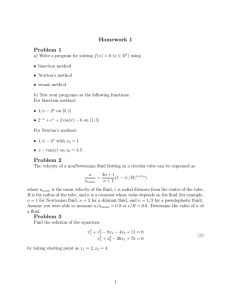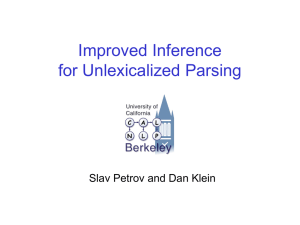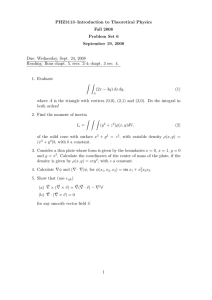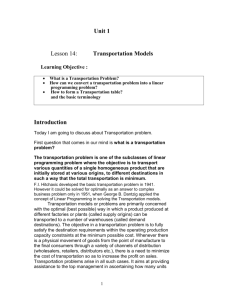New York Journal of Mathematics Mild 2-relator pro-p-groups artner, John Labute
advertisement
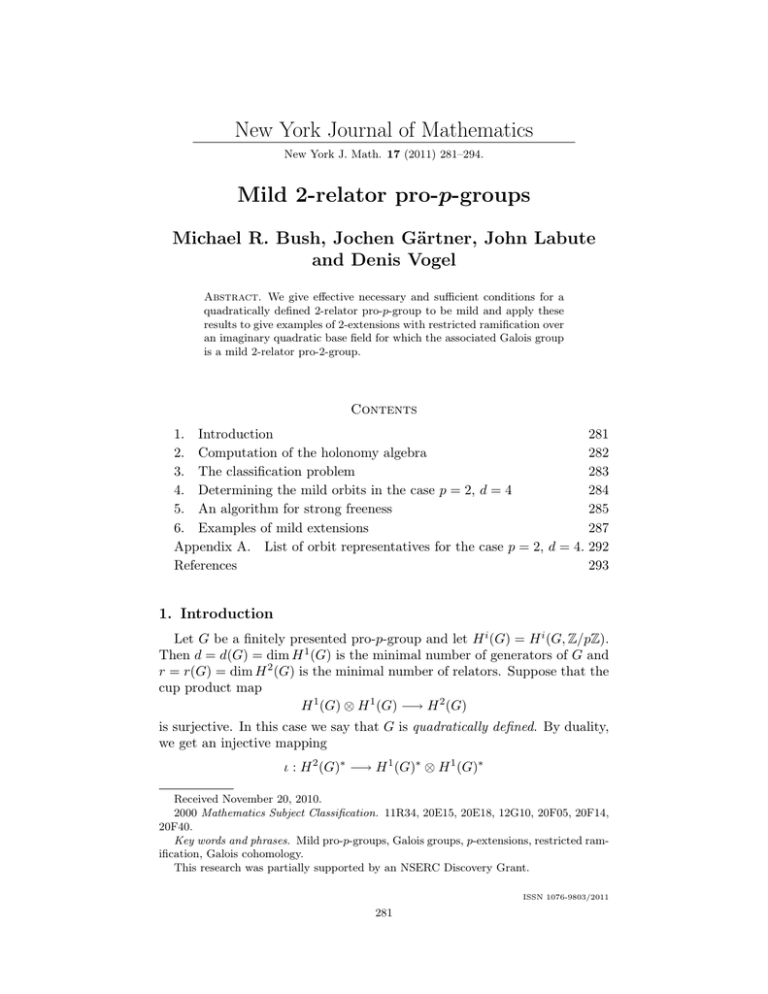
New York Journal of Mathematics
New York J. Math. 17 (2011) 281–294.
Mild 2-relator pro-p-groups
Michael R. Bush, Jochen Gärtner, John Labute
and Denis Vogel
Abstract. We give effective necessary and sufficient conditions for a
quadratically defined 2-relator pro-p-group to be mild and apply these
results to give examples of 2-extensions with restricted ramification over
an imaginary quadratic base field for which the associated Galois group
is a mild 2-relator pro-2-group.
Contents
1. Introduction
281
2. Computation of the holonomy algebra
282
3. The classification problem
283
4. Determining the mild orbits in the case p = 2, d = 4
284
5. An algorithm for strong freeness
285
6. Examples of mild extensions
287
Appendix A. List of orbit representatives for the case p = 2, d = 4. 292
References
293
1. Introduction
Let G be a finitely presented pro-p-group and let H i (G) = H i (G, Z/pZ).
Then d = d(G) = dim H 1 (G) is the minimal number of generators of G and
r = r(G) = dim H 2 (G) is the minimal number of relators. Suppose that the
cup product map
H 1 (G) ⊗ H 1 (G) −→ H 2 (G)
is surjective. In this case we say that G is quadratically defined. By duality,
we get an injective mapping
ι : H 2 (G)∗ −→ H 1 (G)∗ ⊗ H 1 (G)∗
Received November 20, 2010.
2000 Mathematics Subject Classification. 11R34, 20E15, 20E18, 12G10, 20F05, 20F14,
20F40.
Key words and phrases. Mild pro-p-groups, Galois groups, p-extensions, restricted ramification, Galois cohomology.
This research was partially supported by an NSERC Discovery Grant.
ISSN 1076-9803/2011
281
282 MICHAEL R. BUSH, JOCHEN GÄRTNER, JOHN LABUTE AND DENIS VOGEL
and hence an embedding of W = H 2 (G)∗ into the tensor algebra A = T (V )
of V = H 1 (G)∗ over Fp . Let B = A/(W ), where (W ) is the ideal of A
generated by W . Then B is a finitely presented graded algebra over Fp with
d generators and r quadratic relators; it is called the holonomy algebra of G.
If bn = dim Bn , the n-th homogeneous component of B, the formal power
series
X
B(t) =
b n tn
n≥0
is the Poincaré series of B. We have B(t) ≥ (1 − dt + rt2 )−1 , cf. [1]. The
pro-p-group G is called mild if the above inequality is an equality in which
case the algebra B is also called mild. A basis of W is called strongly free if
B = A/(W ) is mild.
Mild pro-p-groups have strong properties; for example, they are of cohomological dimension 2 and the Lie algebra associated to various central
series of such groups can be computed, cf. [3], [5], [6].
Theorem 1. A quadratically defined 2-relator pro-p-group is mild if p 6= 2.
This is not the case when p = 2. However, we have the following result which gives an effective algorithm for determining the mildness of a
quadratically defined pro-2-group.
Theorem 2. A quadratically defined 2-relator pro-2-group is mild if and
only if the codimension of the annihilator of H 1 (G) under the cup-product is
> 2 and ι(H 2 (G)∗ ) contains no nonzero square of an element of T (H 1 (G)∗ ).
2. Computation of the holonomy algebra
Let G = F/R = hx1 , . . . , xd | r1 , r2 i be a finitely presented pro-p-group
with r1 , r2 ∈ F p [F, F ]. Then d(G) = d. The completed Fp -algebra of the free
pro-p-group F can be identified with the algebra of noncommutative formal
power series in X1 , . . . , Xd over Fp . Under this identification, xi = 1 + Xi .
If r ∈ R we have
d
Y 2c Y
[xi , xj ]cij mod F 4 [F, F ]2 [F, [F, F ]] if p = 2,
xi ii
i<j
i=1
r= Y
cij
[x
,
x
mod F p [F, [F, F ]]
if p 6= 2,
i j]
i<j
so that
d
X c X 2 + X c [X , X ] mod terms of degree > 2 if p = 2,
ii i
ij
i
j
i=1
i<j
r= X
cij [Xi , Xj ] mod terms of degree > 2
if p =
6 2.
i<j
Using the transpose of the inverse of the transgression isomorphism
tg : H 1 (R)F = (R/Rp [R, F ])∗ −→ H 2 (G),
MILD 2-RELATOR PRO-p-GROUPS
283
the relator r defines a linear form φr on H 2 (G) such that, if χ1 , . . . , χd is the
basis of H 1 (F ) = (F/F p [F, F ])∗ with χi (xj ) = δij , we have φr (χi ∪ χj ) = cij
if i ≤ j, setting cii = 0 if p 6= 2; cf. [9], Prop. 3.9.13. If we identify xi with
its image in V = F/F p [F, F ] the algebra A = T (V ) can be identified with
the free associative algebra on x1 , . . . , xd over Fp . Moreover,
d
X
X
cii x2i +
cij [xi , xj ] if p = 2,
i=1
i<j
ρ = ι(φr ) = X
cij [xi , xj ]
if p 6= 2,
i<j
which shows that ρ lies in ∧2 V if p 6= 2. If p = 2 then ρ lies in Sq(V ),
the symmetric square of V , which is defined to be the subspace of V ⊗ V
generated by elements of the form x⊗x, x⊗y+y⊗x. Under our identification,
∧2 V is the 2-component L2 of the Lie subalgebra L of A generated by
x1 , . . . , xd and
d
X
Sq(V ) =
F2 x2i + L2
i=1
if p = 2. Let cji = cij for i < j if p = 2 and cji = −cij , cii = 0 if p 6= 2.
Setting X to be the 1 × d matrix [x1 , . . . , xd ], we obtain a symmetric d × d
matrix C = [cij ] such that ρ = XCX t . This matrix is the matrix of the
bilinear form b on H 1 (G) defined by b(χ, ψ) = φr (χ∪ψ). The automorphism
f of V defined by X 7→ XP , where P ∈ GLd (F2 ), extends to an automorphism fˆ of A whose restriction to Sq(V ) if p = 2 and to L2 if p 6= 2 sends
the element ρ to fˆ(ρ) = XP CP t X t .
Proposition 1. Let φi be the linear form on H 2 (G) associated to ri and
let ρi = ι(φi ). Then G is quadratically defined and r(G) = 2 if and only if
ρ1 , ρ2 are linearly independent over Fp , in which case, the holonomy algebra
of G is A/(ρ1 , ρ2 ) which implies that G is mild if and only if the sequence
ρ1 , ρ2 is strongly free.
3. The classification problem
Let Q be the set of graded Fp -algebras of the form A/(ρ1 , ρ2 ) with ρ1 , ρ2
linearly independent elements of Sq(V ) if p = 2 and L2 if p 6= 2. Two
algebras A/(ρ1 , ρ2 ), A/(ρ01 , ρ02 ) ∈ Q are isomorphic if and only if there is an
automorphism f of V and Q ∈ GL2 (Fp ) such that
0
ρ1
fˆ(ρ1 )
=Q ˆ
.
ρ02
f (ρ2 )
The vector space L2 has dimension d2 with basis
{xij = [xi , xj ] | 1 ≤ i < j ≤ d}
284 MICHAEL R. BUSH, JOCHEN GÄRTNER, JOHN LABUTE AND DENIS VOGEL
which we order lexicographically. If p = 2 the symmetric square Sq(V ) has
dimension (d2 + d)/2 over F2 with explicit basis
x21 < · · · < x2d < x12 < x13 < · · · < x23 < x24 < · · · < xd−1,d .
Each relator ρi is determined by its coordinates Y = [ci1 , . . . , cis ] ∈ Fsp with
respect to this basis; here s = d2 if p 6= 2 and s = (d2 + 2)/2 if p = 2. If
P
f (xj ) = di=1 pij xi then, in terms of these coordinates the automorphism fˆ
sends Y to Y P̂ , where P̂ ∈ GLs (Fp ) is determined by
X
fˆ(xij ) =
(pri psj + psi prj )xrs
r<s
fˆ(x2i ) =
d
X
j=1
p2ji x2j +
X
pri psi xrs if p = 2.
r<s
Each algebra in Q is determined by specifying a 2 × s matrix over Fp .
Determining the isomorphism classes of elements of Q reduces to determining the orbit space of 2 × s matrices C over Fp under the action of
Γ = GL2 (Fp ) × GLd (Fp ) where, for (Q, P ) ∈ GL2 (Fp ) × GLd (Fp ),
(Q, P )C = QC P̂ t .
In the case p = 2, d = 4 computations with symbolic algebra package
Magma [8] yield the following result.
Theorem 3. There are 54 orbits of Q under the action of Γ. The size of
each orbit together with a representative is given in Appendix A.
An orbit is called mild if it has a strongly free representative. If one
representative is strongly free then so are all the others.
4. Determining the mild orbits in the case p = 2, d = 4
Theorem 4. The orbits 19, 20, 21, 49, 50, 51, 52, 53, 54 are the only
nonmild orbits when d = 4, p = 2.
These orbits are nonmild since the 4-th term of their Poincaré series is
either 49 or 50 instead of 48.
To prove strong freeness for all but one of the remaining orbits we use
Anick’s criterion which is developed in [1], §6. In order to state Anick’s
criterion we have to define the notion of a combinatorially free sequence.
A sequence of nonidentity monomials α1 , . . . , αd in x1 , . . . , xd is said to be
combinatorially free if:
(1) No monomial αi is a submonomial of αj for i 6= j.
(2) If αi = u1 v1 , αj = u2 v2 is a proper factorization with ui , vi monomials then u1 6= v2 .
MILD 2-RELATOR PRO-p-GROUPS
285
Let an ordering of x1 , . . . , xd be given and order the monomials lexicographically. By the leading term of a homogeneous polynomial w ∈ A we
mean the largest monomial appearing in w (with a nonzero coefficient).
Proposition 2 (Anick’s Criterion). A sequence ρ1 , . . . , ρm of homogeneous
elements of A of degree > 0 is strongly free if the sequence of leading terms
of these elements is combinatorially free.
As an example consider orbit 5 which is represented by
ρ1 = x21 + [x1 , x2 ], ρ2 = [x1 , x3 ].
The leading terms for the ordering x1 < x2 < x3 < x4 are x2 x1 , x3 x1
which are combinatorially free. The remaining orbits, except for orbit 28
are handled in this way.
To handle orbit 28 we need a more powerful criterion for mildness that was
obtained by Patrick Forré [3]. There he proves a result on how sequences
in A can be modified in a certain way such that strongly free sequences
remain strongly free by assigning different weights e = (e1 , e2 , e3 , e4 ) to the
basis X = (x1 , x2 , x3 , x4 ). Dealing with different gradings (X, e) at the
same time together with Anick’s criterion, this gives an alternative proof
of the cup product criterion for cohomological dimension 2 (especially for
pro-2-groups, cf. [6], Th. 1.1).
Proposition 3 (Forré’s Theorem). Let w1 + v1 , . . . , wr + vr be a sequence
of homogenous elements of A. Then this sequence is strongly free in A if
there is a grading (X, e) such that:
(a) w1 , . . . , wr is a strongly free sequence of e-homogeneous elements of
A.
(b) For each e-homogeneous component u of vj , we have
dege u > dege (wj ).
Proof. For a proof we refer to [3], Cor. 3.8 and 3.10.
Orbit 28 is represented by ρ1 = x21 + [x1 , x3 ], ρ2 = x22 + [x1 , x2 ]. For the
(X, e)-grading with e1 = 2, e2 = 3, e3 = e4 = 1 the e-homogeneous terms
of lowest degree of ρ1 , ρ2 are [x1 , x3 ], [x1 , x2 ] whose highest terms for the
ordering x1 < x2 < x3 < x4 are x3 x1 , x2 x1 , a combinatorially free sequence.
5. An algorithm for strong freeness
Theorem 5. The Γ-orbit of an algebra in Q contains a representative B =
A/(ρ1 , ρ2 ) with ρ1 , ρ2 in exactly one of the following forms with L, L1 , L2 ∈
L2 , L1 , L2 6= 0:
(I) ρ1 , ρ2 ∈ L2 , ρ1 , ρ2 6= 0, ρ1 6= ρ2 .
(II) ρ1 = x21 + L1 , ρ2 = L2 , with L1 6= L2 .
(III) ρ1 = x21 , ρ2 ∈ L2 , ρ2 6= 0.
286 MICHAEL R. BUSH, JOCHEN GÄRTNER, JOHN LABUTE AND DENIS VOGEL
(IV) ρ1 = x21 + L1 , ρ2 = x22 + L2 with L1 + L2 6= 0, [x1 , x2 ] or L1 = L2 6=
[x1 , x2 ].
(V) ρ1 = x21 + [x1 , x2 ], ρ2 = x22 + [x1 , x2 ].
(VI) ρ1 = x21 , ρ2 = x22 + L.
The orbit is mild if and only if it is of type (I), (II) or (IV).
Proof. Let B : H 1 (G) → H 2 (G) be the linear mapping defined by B(χ) =
χ ∪ χ and let t = codimKer(B). Let s be the codimension of the annihilator
of H 1 (G) under the cup-product. Note that p 6= 2 can only occur for type
(I).
The representative ρ1 , ρ2 is of type (I) if and only if t = 0 in which case
s ≥ 3. After a change of variables we can assume that the largest term
of ρ2 is [xk , xd ]. Let a[xi , xj ] with i < j be the largest term of ρ1 . After
possibly subtracting from ρ1 a scalar multiple of ρ2 we may assume that
[xi , xj ] 6= [xk , xd ]. To prove mildness we use Anick’s criterion. If j = d then
the highest monomials in ρ1 , ρ2 are xd xi , xd xk which are combinatorially
free. If j < d, j 6= k, the highest monomials are xj xi , xd xk which are
combinatorially free. If j < d, j = k then, for the ordering of x1 , . . . , xd in
which xd < xk are largest, the highest monomials are xk xi , xk xd which are
combinatorially free. Hence type (I) is mild.
We are in types (II) or (III) if and only if t = 1 in which case we may
assume, without loss of generality, that ρ1 = x21 + L1 , ρ2 = L2 with L1 , L2 ∈
L2 . If L1 = 0 we are in type (III); if L1 = L2 then after subtracting ρ2
from ρ1 we fall in type (III). To show that type (III) is not mild let R be
the ideal of A generated by ρ1 , ρ2 and let I be the augmentation ideal of
A. Since [x1 , ρ1 ] = 0 we see that x1 ρ1 ≡ 0 mod RI and hence that R/RI
is not a free B-module on the images of ρ1 , ρ2 . This implies that ρ1 , ρ2 are
not strongly free, cf. [3]. If ρ1 , ρ2 are of type (II) we prove mildness exactly
as for type (I).
We are in type (IV), (V), or (VI) if and only if t = 2. Type (VI) is
not-mild which is proven in the same way as for type (III). Type (V) is not
mild since [x2 , ρ1 ] + [x1 , ρ2 ] = 0.
Now suppose that ρ1 , ρ2 are of type (IV) with L1 = L2 = L. If we add ρ2
to ρ1 and replace x1 by x1 + x2 we get ρ1 = x21 + [x1 , x2 ], ρ2 = x22 + L0 with
L0 6= [x1 , x2 ]. Hence, after a change of variables, we can assume that the
largest term of L0 is [xk , xd ] with d > 2. The highest monomials in ρ2 , ρ2 are
x2 x1 , xd xk which are combinatorially free if k 6= 2. If k = 2 we apply Forré’s
Theorem with e1 = 3, e2 = 2, ed = 1, eh = 2 for h 6= 1, 2, d. In this case
the homogeneous components of lowest degree for ρ1 , ρ2 are [x1 , x2 ], [x2 , xd ]
whose highest monomials for the ordering in which x1 < xd < x2 are the
combinatorially free monomials x2 x1 , x2 xd .
Now suppose that ρ1 , ρ2 are of type (IV) with L1 6= L2 , L1 +L2 6= [x1 , x2 ].
Without loss of generality, we can assume the largest term of ρ2 is [xk , xd ]
with d > 2. Let [xi , xj ] with i < j be the largest term of ρ1 .
MILD 2-RELATOR PRO-p-GROUPS
287
Suppose first that [xi , xj ] 6= [xk , xd ]. If j = d or j 6= d, k 6= j the highest
monomials of ρ1 , ρ2 are xj xi , xd xk which are combinatorially free. If j 6= d
and k = j 6= 2 then, for the ordering in which the largest variables are
xd < xj , the highest monomials are xk xi , xk xd which are combinatorially
free. If j 6= d, k = j = 2 then
ρ1 = x21 + [x1 , x2 ], ρ2 = x22 +
d
X
ah [x1 , xh ] +
h=2
d−1
X
bh [x2 , xh ] + [x2 , xd ].
h=3
If we apply Forré’s Theorem with e1 = 3, e2 = 2, ed = 1, eh = 2 for h 6=
1, 2, d, the homogeneous components of lowest degree for ρ1 , ρ2 are [x1 , x2 ],
[x2 , xd ] whose highest monomials for the ordering in which x1 < xd < x2 are
the combinatorially free monomials x2 x1 , x2 xd .
Now suppose that [xi , xj ] = [xk , xd ]. If i = k > 2 then, after adding ρ2 to
ρ1 and replacing x1 by x1 + x2 , the largest term of ρ1 is a nonzero element
of L2 which is not equal to [xk , xd ], the largest term of ρ2 . This reduces us
to the previous case in which that ρ1 , ρ2 were strongly free. Now suppose
i = k = 2. We have
ρ1 = x21 + M1 + [x2 , xd ], ρ2 = x22 + M2 + [x2 , xd ].
Since L1 + L2 6= 0, [x1 , x2 ] exactly one of M1 , M2 , say M1 , has a term
[x1 , xh ] or [x2 , xh ] with h 6= 1, 2, d which we can assume to be the latter if
both appear. If we change the ordering by making xh largest, the highest
monomials are xh x2 , xd x2 which are combinatorially free. In the same way
we can prove that ρ1 , ρ2 are combinatorially free if i = k = 1.
Theorems 1 and 2 follow immediately from this result.
6. Examples of mild extensions
Let k be a totally imaginary number field and S a finite set of primes
of k. The pro-2-group GS (2) = Gal(kS (2)/k), i.e. the Galois group of
the maximal 2-extension of k unramified outside S, contains interesting
information on the arithmetic of k. In the case where the set of primes
S2 of k above 2 is contained in S - the wild case - it has been known for a
long time that GS (2) is of cohomological dimension less than or equal to 2,
see [9].
In the tame case, where S ∩ S2 = ∅ and in the mixed case, where ∅ (
S ∩ S2 ( S2 , only little had been known about the structure of GS (2) until
recently. The results of [6] on mild pro-2-groups apply to an arithmetic
result of Schmidt [10] which in turn yields a theorem that deals with all
the above cases: For any given finite set S 0 of primes of k, there exists a
finite set T of primes of k of odd norm such that for S = S 0 ∪ T , the group
GS (2) is of cohomological dimension 2. A natural question in this context
is whether one can even prove the stronger property of mildness of GS (k)
in some situations, in particular when we are given presentations that are
288 MICHAEL R. BUSH, JOCHEN GÄRTNER, JOHN LABUTE AND DENIS VOGEL
not of Koch-type. In the following, we will give some examples of mild pro2-groups with 4 generators and 2 relators occuring as GS (2) for imaginary
quadratic number fields, making use of our classification.
Finally we will also give an arithmetic example of a nonmild 4-generator
2-relator pro-2 group, which occurs as GS (2) over a cubic field. A good reference for a general discussion of the calculations we will carry out explicitly
in our examples is section 11.4 of [4]. We will use the same notation and
refer to this for more background and details.
√
√
Example 1. Let k = Q( −7), S = {p, p, q}, where p = 1+ 2 −7 and
√
√
p = 1− 2 −7 are the primes of k above 2 and q = (2 + −7) is one of the
primes of k above 11. Then GS (2) is a mild pro-2-group on 4 generators
and 2 relators corresponding to orbit 39 in the list given in Appendix A.
Proof. The ideal class group of k is trivial, and we have
V∅ = {α ∈ k × | α ∈ Ul kl×2 for all primes l of k}/k ×2 ∼
= {±1},
where kl denotes the completion of k at l and Ul denotes the unit group of
kl . Since −1 is not a square in Q2 = kp , we have
VS = {α ∈ k × | α ∈ kl×2 for l ∈ S, α ∈ Ul kl×2 for l 6∈ S}/k ×2 = 1.
Let US be the subgroup of the idele group Ik consisting of those ideles whose
components for l ∈ S are 1 and for l 6∈ S are units. Then we have an exact
sequence
Q
0 −−−−→ {±1} −−−−→ l∈S Ul /Ul2 −−−−→ Ik /(US Ik2 k × ) −−−−→ 0
and an isomorphism
Ik /(US Ik2 k × ) ∼
= GS (2)/GS (2)2 .
In particular, the generator rank of GS (2) is given by
dimF2 Up /Up2 + dimF2 Up /Up2 + dimF2 Uq /Uq2 − 1 = 2 + 2 + 1 − 1 = 4.
We set αp,1 = 5, αp,2 = −1, αp,1 = 5, αp,2 = −1, αq = −1. Then
{αp,1 , αp,2 }, {αp,1 , αp,2 } and {αq } are bases of Up /Up2 , Up /Up2 and Uq /Uq2 ,
respectively. Let P be fixed prime divisor of p in kS . Let τp,1 be an element of the inertia group of P whose restriction to the maximal abelian
subextension L/k of kS (2)/k equals (α̂p,1 , L/k), where α̂p,1 denotes the element of the idele group Ik of k whose p-component equals αp,1 and all other
components are equal to 1. In an analogous way we define τp,2 , τp,1 , τp,2 , τq .
Then {τp,1 , τp,2 , τp,1 , τp,2 , τq } is a nonminimal set of generators of GS (2). We
have to determine which one of the generators we can omit. In the group
Ik /(US Ik2 k × ) we have the identity
−1 ≡ α̂p,2 α̂p,2 α̂q
mod US Ik2 k × ,
and therefore
τq ≡ τp,2 τp,2
mod GS (2)2 .
MILD 2-RELATOR PRO-p-GROUPS
289
So we can omit τq , and {τp,1 , τp,2 , τp,1 , τp,2 } is a minimal set of generators
of GS (2). Now we have to deal with the relators. By [4], we have relators
rp , rp , rq (which we will determine shortly) of which we can omit any. We
omit rq , hence GS (2) has a minimal presentation (as pro-2-group)
GS (2) = hτp,1 , τp,2 , τp,1 , τp,2 | rp = rp = 1i.
√
√
We have yet to determine rp and rp . We set πp = 1+ 2 −7 and πp = 1− 2 −7 .
Let σp be a lift of the Frobenius automorphism of P (with respect to the
maximal subextension of kS /k in which P is unramified) whose restriction
to L/k is given by (π̂p , L/k). In an analogous way, we define σp . We calculate the following Hilbert symbols in kp : (αp,1 , αp,2 ) = 1, (αp,1 , πp ) = −1,
(αp,2 , πp ) = −1. For the Hilbert symbols in kp we obtain (αp,1 , αp,2 ) = 1,
(αp,1 , πp ) = −1, (αp,2 , πp ) = −1. This means that rp is given by
2
rp = σp2 τp,2
[τp,1 , σp ],
and the relator rp is given by
2
rp = σp2 τp,2
[τp,1 , σp ]
(note that there is a mistake in [4] concerning the signs of the Hilbert symbols, as a consequence the squares of Frobenius are missing there). Computations in Magma [8] show that
π̂p ≡ α̂p,1 α̂p,2
mod US Ik2 k × ,
and
π̂p ≡ α̂p,1 α̂p,2 α̂q
mod US Ik2 k × ,
so
σp ≡ τp,1 τp,2
mod GS (2)2 ,
and
σp ≡ τp,1 τp,2 τq ≡ τp,1 τp,2 τp,2 τp,2 ≡ τp,1 τp,2
We obtain that
mod GS (2)2 .
2
2
rp = σp2 τp,2
[τp,1 , σp ] ≡ (τp,1 τp,2 )2 τp,2
[τp,1 , τp,1 τp,2 ]
2 2 2
≡ τp,2
τp,1 τp,2 [τp,1 , τp,1 ][τp,1 , τp,2 ][τp,1 , τp,2 ]
mod GS (2)3
and
2
2
rp = σp2 τp,2
[τp,1 , σp ] ≡ (τp,1 τp,2 )2 τp,2
[τp,1 , τp,1 τp,2 ]
2
≡ τp,1
[τp,1 , τp,1 ][τp,1 , τp,2 ][τp,1 , τp,2 ]
mod GS (2)3 .
Therefore, GS (2) has a presentation by generators x1 , x2 , x3 , x4 and relators
whose initial forms ρ1 , ρ2 are given by
ρ1 = x22 + x23 + x24 + [x1 , x3 ] + [x1 , x4 ] + [x3 , x4 ],
ρ2 = x21 + [x1 , x3 ] + [x1 , x4 ] + [x3 , x4 ].
One can check that this presentation belongs to orbit 39 and hence is mild.
In fact, applying the automorphism f given by f (x1 ) = x2 , f (x2 ) = x2 +
290 MICHAEL R. BUSH, JOCHEN GÄRTNER, JOHN LABUTE AND DENIS VOGEL
x4 , f (x3 ) = x1 + x3 + x4 , f (x4 ) = x2 + x3 , yields the representative given
for orbit 39 in Appendix A.
√
√
Example 2. Let k = Q( −7), S = {p, p, q}, where p = 1+ 2 −7 and
√
p = 1− 2 −7 are the primes of k above 2 and q is the unique prime of k
above 3. Then GS (2) is a mild pro-2-group on 4 generators and 2 relators
corresponding to orbit 17.
Proof. We proceed in the same way as in Example 1, except that we set
αq = ζ8 where ζ8 denotes a primitive eighth root of unity in kq . Then
{τp,1 , τp,2 , τp,1 , τp,2 , τq } is a nonminimal set of generators of GS (2). In the
group Ik /(US Ik2 k × ) we have the identity
mod US Ik2 k × ,
−1 ≡ α̂p,2 α̂p,2
and therefore
τp,2 ≡ τp,2
mod GS (2)2 .
So we can omit τp,2 , and {τp,1 , τp,2 , τp,1 , τq } is a minimal set of generators of
GS (2). By [4], we have relators rp , rp , rq , and we can omit any of them. √We
choose to omit rp . We have yet to determine rp and rq . We set πp = 1+ 2 −7
and πq = 3 and define σp and σq as in Example 1. The relator rp is given as
in Example 1 by
2
rp = σp2 τp,2
[τp,1 , σp ].
The relator rq is given by
N (q)−1
rq = τq
[τq , σq ] = τq8 [τq , σq ].
Using Magma [8] we obtain that
π̂p ≡ α̂p,1 α̂p,2 α̂q
mod US Ik2 k × ,
and
π̂q ≡ α̂p,1 α̂p,2 α̂p,1 α̂p,2
mod US Ik2 k × .
Hence,
σp ≡ τp,1 τp,2 τq ≡ τp,2 τp,1 τq
mod GS (2)2 ,
and
σq ≡ τp,1 τp,2 τp,1 τp,2 ≡ τp,1 τp,1
mod GS (2)2 .
It follows that
2
2
rp = σp2 τp,2
[τp,1 , σp ] ≡ (τp,2 τp,1 τq )2 τp,2
[τp,1 , τp,2 τp,1 τq ]
2 2
≡ τp,1
τq [τp,1 , τp,2 ][τp,1 , τp,1 ][τp,1 , τq ][τp,2 , τp,1 ][τp,2 , τq ][τp,1 , τq ]
mod GS (2)3
and
rq = τq8 [τq , σq ] ≡ [τq , τp,1 τp,1 ] ≡ [τq , τp,1 ][τq , τp,1 ]
mod GS (2)3 .
MILD 2-RELATOR PRO-p-GROUPS
291
Therefore, GS (2) has a presentation by generators x1 , x2 , x3 , x4 and relators
whose initial forms ρ1 , ρ2 are given by
ρ1 = x23 + x24 + [x1 , x2 ] + [x1 , x3 ] + [x1 , x4 ] + [x2 , x3 ] + [x2 , x4 ] + [x3 , x4 ],
ρ2 = [x1 , x4 ] + [x3 , x4 ].
Applying Anick’s criterion with x4 < x3 < x2 < x1 , we see that GS (2)
is mild. More precisely, applying the automorphism f given by f (x1 ) =
x1 + x4 , f (x2 ) = x1 + x3 , f (x3 ) = x1 + x2 + x4 , f (x4 ) = x2 + x4 we obtain
the representative for orbit 17 in Appendix A.
√
Example 3. Let k = Q( 3 3), S = {p, p, q}, where q denotes the real prime
√
√
√ 2
of k and p = ( 3 3 − 1) and p = (1 + 3 3 + 3 3 ) are the primes of k above 2.
Then GS (2) is pro-2-group on 4 generators and 2 relators corresponding to
the nonmild orbit 54.
Proof. First let us remark that since the field k is not totally imaginary
and S contains the real prime of k, complex conjugation induces a nontrivial
2-torsion element in GS (2). In particular, it follows that GS (2) has infinite
cohomological dimension and therefore cannot be mild. In the following
we show that d(GS (2)) = 4, r(GS (2)) = 2 and in fact GS (2) belongs to
orbit 54. Again k has trivial ideal class group, and it follows that a F2 basis for V∅ is given by the residue classes of −1, −ε modulo k ×2 , where
√ 2
√
ε = 4 + 3 3 3 + 2 3 3 is a fundamental unit. Clearly −1, −ε are not squares
in kq = R and furthermore ε is not a square in kp = Q2 . Hence it follows
that VS = 1. The primes p and p have inertia degrees 1 and 2 respectively
and by chapter 11 of [4] it follows that d(GS (2)) = 4, r(GS (2)) ≤ 2. We set
√
3
αp,1 := 5, αp,2 := −1, αp,1 := 1 + 4 3, αp,2 := −1, αp,3 := ε, αq := −1.
Then the sets {αp,1 , αp,2 }, {αp,1 , αp,2 , αp,3 }, {αq } are bases of Up /Up2 , Up /Up2
and Uq /Uq2 respectively. As in the previous examples we may choose a
corresponding nonminimal set of generators {τp,1 , τp,2 , τp,1 , τp,2 , τp,3 , τq } of
GS (2). By class field theory the identities of ideles
mod US Ik2 k × ,
−1 ≡α̂p,2 α̂p,2 α̂q,2
mod US Ik2 k ×
ε ≡α̂p,2 α̂p,3
yield
τp,2 ≡ τp,3 ≡ τp,2 τq mod GS (2)2
and hence {τp,1 , τp,1 , τp,2 , τq } is a minimal set of generators of GS (2). By [4],
we have relators rp , rp , rq , and we can omit any of them. We choose to omit
rp . The relator rq belonging to the infinite prime is given by
rq = τq2 .
√
We set πp = 3 3 − 1 and define σp as in Example 1 and 2. We calculate the
following Hilbert symbols in kp : (αp,1 , αp,2 ) = 1, (αp,1 , πp ) = −1, (αp,2 , πp ) =
292 MICHAEL R. BUSH, JOCHEN GÄRTNER, JOHN LABUTE AND DENIS VOGEL
1. Therefore rp is given by
2 2
2
rp = τp,2
[τp,1 , σp ] ≡ τp,2
τq [τp,1 , σp ][τp,2 , τq ]
mod GS (2)3 .
Note that, contrary to the previous examples, the Hilbert symbol (αp,2 , πp )
being trivial implies that there is no square of the Frobenius.
Using Magma [8] we find that
π̂p ≡ α̂p,1
mod US Ik2 k × ,
so
σp ≡ τp,1
mod GS (2)2
and we obtain
2 2
τq [τp,1 , τp,1 ][τp,2 , τq ]
rp ≡ τp,2
mod GS (2)3 .
Therefore GS (2) admits a presentation by generators x1 , x2 , x3 , x4 and two
relators with initial forms ρ1 , ρ2 given by
ρ1 = x23 + x24 + [x1 , x2 ] + [x3 , x4 ],
ρ2 = x24 .
By making the successive substitutions x1 ↔ x4 , x2 ↔ x3 , x2 7→ x1 + x2 one
checks that this presentation belongs to orbit 54.
Appendix A. List of orbit representatives for the case p = 2,
d = 4.
This is a list of orbit representatives followed by the size and type of the
orbit for the case p = 2, d = 4.
(1)
(2)
(3)
(4)
(5)
(6)
(7)
(8)
(9)
(10)
(11)
(12)
(13)
(14)
(15)
(16)
(17)
(18)
[x1 , x2 ], [x1 , x3 ], 630, (I)
[x1 , x2 ], [x3 , x4 ], 1680, (I)
[x1 , x2 ], [x1 , x4 ] + [x2 , x3 ], 1260, (I)
[x1 , x2 ] + [x3 , x4 ], [x1 , x3 ] + [x2 , x4 ] + [x3 , x4 ], 336, (I)
x21 + [x1 , x2 ], [x1 , x3 ] , 1890, (II)
x21 + [x1 , x2 ], [x3 , x4 ], 10080, (II)
x21 + [x1 , x2 ], [x1 , x2 ] + [x3 , x4 ], 10080, (II)
x21 + [x1 , x2 ], [x1 , x4 ] + [x2 , x3 ], 7560, (II)
x21 + [x1 , x3 ], [x2 , x3 ], 7560, (II)
x21 + [x1 , x3 ] + [x2 , x4 ], [x2 , x3 ], 15120, (II)
x21 + [x1 , x3 ] + [x2 , x4 ], [x1 , x2 ] + [x2 , x4 ] + [x3 , x4 ], 15120, (II)
x21 + [x1 , x4 ] + [x2 , x3 ], [x1 , x2 ], 3780, (II)
x21 + [x1 , x4 ] + [x2 , x3 ], [x1 , x2 ] + [x3 , x4 ], 181440, (II)
x21 + [x2 , x3 ], [x1 , x3 ], 3780, (II)
x21 + [x2 , x3 ], [x1 , x4 ], 10080, (II)
x21 + [x2 , x3 ], [x1 , x4 ] + [x2 , x4 ], 30240, (II)
x21 + [x3 , x4 ], [x2 , x4 ], 15120, (II)
x21 + [x3 , x4 ], [x1 , x2 ] + [x1 , x4 ] + [x2 , x3 ], 15120, (II)
MILD 2-RELATOR PRO-p-GROUPS
(19)
(20)
(21)
(22)
(23)
(24)
(25)
(26)
(27)
(28)
(29)
(30)
(31)
(32)
(33)
(34)
(35)
(36)
(37)
(38)
(39)
(40)
(41)
(42)
(43)
(44)
(45)
(46)
(47)
(48)
(49)
(50)
(51)
(52)
(53)
(54)
293
x21 , [x1 , x2 ], 630, (III)
x21 , [x2 , x3 ], 2520, (III)
x21 , [x1 , x4 ] + [x2 , x3 ], 2520, (III)
x21 + [x1 , x2 ], x22 + [x1 , x3 ], 3780, (IV)
x21 + [x1 , x2 ], x22 + [x3 , x4 ], 10080, (IV)
x21 + [x1 , x2 ], x22 + [x1 , x2 ] + [x3 , x4 ], 10080, (IV)
x21 + [x1 , x2 ], x22 + [x1 , x4 ] + [x2 , x3 ], 7560, (IV)
x21 + [x1 , x2 ] + [x3 , x4 ], x22 + [x1 , x3 ] + [x2 , x4 ] + [x3 , x4 ], 60480 (IV)
x21 + [x1 , x2 ] + [x2 , x3 ], x22 + [x1 , x3 ] + [x2 , x4 ] + [x3 , x4 ], 60480, (IV)
x21 + [x1 , x3 ], x22 + [x1 , x2 ], 7560, (IV)
x21 + [x1 , x3 ], x22 + [x2 , x3 ], 2520, (IV)
x21 + [x1 , x3 ], x22 + [x2 , x4 ], 15120, (IV)
x21 + [x1 , x3 ], x22 + [x1 , x4 ] + [x2 , x4 ], 30240, (IV)
x21 + [x1 , x3 ] + [x2 , x4 ], x22 + [x1 , x3 ] + [x1 , x4 ] + [x2 , x3 ], 5040, (IV)
x21 + [x1 , x3 ] + [x3 , x4 ], x22 + [x1 , x3 ] + [x2 , x3 ] + [x2 , x4 ], 120960, (IV)
x21 + [x1 , x4 ], x22 + [x3 , x4 ], 60480, (IV)
x21 + [x1 , x4 ], x22 + [x1 , x3 ] + [x2 , x4 ], 15120, (IV)
x21 + [x1 , x4 ], x22 + [x2 , x3 ] + [x3 , x4 ], 30240, (IV)
x21 + [x1 , x4 ], x22 + [x1 , x3 ] + [x2 , x3 ] + [x2 , x4 ] + [x3 , x4 ], 30240, (IV)
x21 + [x1 , x4 ] + [x2 , x3 ], x22 + [x1 , x3 ] + [x2 , x3 ] + [x2 , x4 ], 5040, (IV)
x21 + [x1 , x4 ] + [x2 , x4 ], x22 + [x1 , x3 ] + [x2 , x3 ] + [x3 , x4 ], 60480, (IV)
x21 + [x1 , x4 ] + [x2 , x4 ], x22 + [x1 , x3 ] + [x1 , x4 ] + [x2 , x3 ], 30240, (IV)
x21 + [x2 , x3 ], x22 + [x1 , x3 ], 7560, (IV)
x21 + [x2 , x3 ], x22 + [x1 , x3 ] + [x2 , x3 ], 5040, (IV)
x21 + [x2 , x3 ], x22 + [x1 , x4 ] + [x2 , x3 ], 30240, (IV)
x21 + [x2 , x4 ], x22 + [x1 , x3 ], 15120, (IV)
x21 + [x2 , x4 ], x22 + [x2 , x3 ], 15120, (IV)
x21 + [x3 , x4 ], x22 + [x1 , x4 ], 60480, (IV)
x21 + [x3 , x4 ], x22 + [x2 , x3 ] + [x2 , x4 ] + [x3 , x4 ], 60480, (IV)
x21 +[x3 , x4 ], x22 +[x1 , x2 ]+[x1 , x4 ]+[x2 , x3 ]+[x2 , x4 ]+[x3 , x4 ], 60480,
(IV)
x21 + [x1 , x2 ], x22 + [x1 , x2 ], 210, (V)
x21 , x22 , 630, (VI)
x21 , x22 + [x1 , x3 ], 3780, (VI)
x21 , x22 + [x1 , x4 ] + [x2 , x3 ], 7560, (VI)
x21 , x22 + [x2 , x3 ], 7560, (VI)
x21 , x22 + [x3 , x4 ], 20160, (VI)
References
[1] Anick, David J. Noncommutative graded algebras and their Hilbert series. J. Algebra
78 (1982), 120–140. MR0677714 (84g:16001), Zbl 0502.16002.
[2] Bush, Michael R.; Labute, John. Mild pro-p groups with 4 generators, J. Algebra
308 (2007), 828–839. MR2295092 (2008g:20054), Zbl 1119.20033.
[3] Forré, Patrick. Strongly free sequences and pro-p-groups of cohomological dimension 2. J. Reine Angew. Math., to appear.
294 MICHAEL R. BUSH, JOCHEN GÄRTNER, JOHN LABUTE AND DENIS VOGEL
[4] Koch, Helmut. Galois theory of p-extensions. With a foreword by I. R. Shafarevich.
Translated from the 1970 German original by Franz Lemmermeyer. With a postscript
by the author and Lemmermeyer. Springer Monographs in Mathematics. SpringerVerlag, Berlin, 2002. xiv+190 pp. ISBN: 3-540-43629-4. MR1930372 (2003f:11181),
Zbl 1023.11002.
[5] Labute, John. Mild pro-p-groups and Galois groups of p-extensions of Q. J. Reine
Angew. Math. 596 (2006), 155–182. MR2254811 (2007j:11158), Zbl 1122.11076.
[6] Labute, John; Mináč, Ján. Mild pro-2-groups and 2-extensions with restricted
ramification. J. Algebra 332 (2011), 136–158.
[7] Lazard, M. Groupes analytiques p-adiques. Inst. Hautes tudes Sci. Publ. Math. No.
26 (1965), 389–603. MR0209286 (35 #188), Zbl 0139.02302.
[8] Bosma, Wieb; Cannon, John. Handbook of Magma functions. School of Mathematics and Statistics, University of Sydney, 1996.
[9] Neukirch, Jürgen; Schmidt, Alexander; Wingberg, Kay. Cohomology of number fields. Second edition. Grundlehren der mathematischen Wissenschaften 323.
Springer Verlag, Berlin, 2008. xvi+825 pp. ISBN: 978-3-540-37888-4. MR2392026
(2008m:11223), Zbl 1136.11001.
[10] Schmidt, Alexander. Über Pro-p-Fundamentalgruppen markierter arithmetischer
Kurven. J. Reine Angew. Math. 640 (2010), 203–235. MR2629694, Zbl 1193.14041.
Dept. of Mathematics & Statistics, Smith College, Northampton, MA 01062,
USA
mbush@smith.edu
Universität Heidelberg, Mathematisches Institut, Im Neuenheimer Feld 288,
69120 Heidelberg, Germany
gaertner@mathi.uni-heidelberg.de
Dept. of Mathematics & Statistics, McGill University, Burnside Hall, 805
Sherbrooke Street West, Montreal, QC H3A 2K6, Canada
labute@math.mcgill.ca
Universität Heidelberg, Mathematisches Institut, Im Neuenheimer Feld 288,
69120 Heidelberg, Germany
vogel@mathi.uni-heidelberg.de
This paper is available via http://nyjm.albany.edu/j/2011/17-14.html.
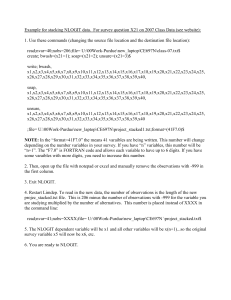

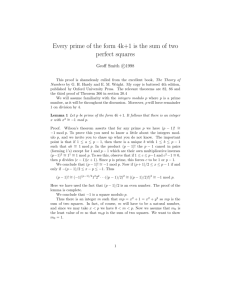
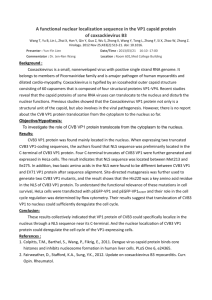
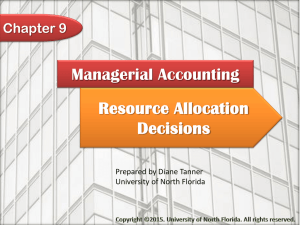
![√ 1. Let q be a prime, R = Z and... q]. Find the primes in S](http://s2.studylib.net/store/data/010491182_1-a8503f2fcaab37dfc44af847b3bc311e-300x300.png)
